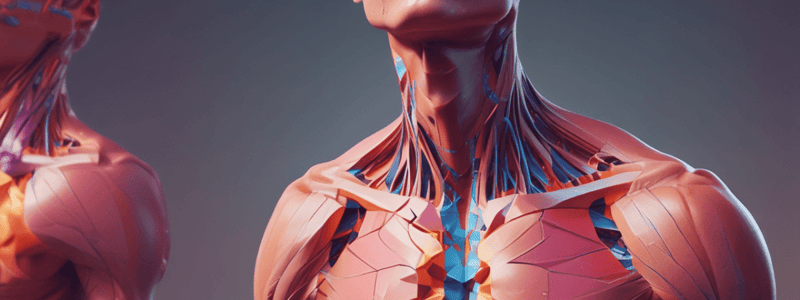Podcast
Questions and Answers
What is the other name for the inferior carotid triangle?
What is the other name for the inferior carotid triangle?
- Occipital triangle
- Subclavian triangle
- Muscular triangle (correct)
- Posterior triangle
Which of the following structures is NOT located in the neck region?
Which of the following structures is NOT located in the neck region?
- Trachea
- Esophagus
- Gallbladder (correct)
- Muscles like thyrohyoid and hyoglossus
What structure divides the posterior triangle of the neck into the occipital triangle and subclavian triangle?
What structure divides the posterior triangle of the neck into the occipital triangle and subclavian triangle?
- Superior belly of the omohyoid
- Inferior belly of the omohyoid (correct)
- Midline of the neck
- Sternocleidomastoid muscle
Which of the following muscles is NOT mentioned in the text as being located in the neck region?
Which of the following muscles is NOT mentioned in the text as being located in the neck region?
What is the primary purpose of understanding the anatomy of the neck region?
What is the primary purpose of understanding the anatomy of the neck region?
Which muscle in the neck aids in turning the head in multiple directions?
Which muscle in the neck aids in turning the head in multiple directions?
Which muscle controls the depth of the throat during swallowing?
Which muscle controls the depth of the throat during swallowing?
Which muscle assists in moving the head backward and downward?
Which muscle assists in moving the head backward and downward?
Which triangle is bordered by the mandible superiorly?
Which triangle is bordered by the mandible superiorly?
Which triangle is posteriorly bordered by the sternocleidomastoid muscle?
Which triangle is posteriorly bordered by the sternocleidomastoid muscle?
Which structure runs between the superficial cervical fascia and the deeper muscles of the neck?
Which structure runs between the superficial cervical fascia and the deeper muscles of the neck?
Flashcards
Digastric Muscle
Digastric Muscle
Neck muscle that forms the borders of the submandibular and submaxillary triangles.
Omohyoid Muscle
Omohyoid Muscle
Neck muscle that borders the carotid triangles.
Sternocleidomastoid Muscle
Sternocleidomastoid Muscle
Neck muscle that aids in head turning.
Trapezius Muscle
Trapezius Muscle
Signup and view all the flashcards
Platysma Muscle
Platysma Muscle
Signup and view all the flashcards
Submandibular Triangle
Submandibular Triangle
Signup and view all the flashcards
Carotid Triangle
Carotid Triangle
Signup and view all the flashcards
Muscular Triangle
Muscular Triangle
Signup and view all the flashcards
Posterior Triangle
Posterior Triangle
Signup and view all the flashcards
Deep Cervical Fascia
Deep Cervical Fascia
Signup and view all the flashcards
Esophagus
Esophagus
Signup and view all the flashcards
Study Notes
Anatomy and Divisions of the Neck
The neck is an essential yet often overlooked area of the human body. It serves as a critical link between the head and the rest of the body. This article will explore the anatomy of the neck, including its muscles and divisions.
Muscles of the Neck
Neck muscles play a crucial role in supporting the head and maintaining various facial expressions. Some key muscles include:
- Digastric: Forms the borders of the submandibular triangle and submaxillary triangle.
- Omohyoid: Borders the superior carotid triangle and the inferior carotid triangle.
- Sternocleidomastoid: Aids in turning the head in multiple directions.
- Trapezius: Assists in moving the head backward and downward.
- Platysma: Controls the depth of the throat during swallowing and helps maintain neck posture.
These muscles are further supported by the deep cervical fascia, which runs between the superficial cervical fascia and the deeper muscles of the neck, dividing into three layers: the superficial, middle, and deep layers.
Divisions of the Neck
The neck's structure is organized into several triangles:
- Submandibular Triangle: Bordered by the mandible superiorly, the anterior and posterior bellies of the digastric muscle, and the mylohyoid muscle.
- Carotid Triangle: Posteriorly bordered by the sternocleidomastoid muscle, anteriorly by the omohyoid muscle, and superiorly by the stylohyoid muscle and posterior belly of the digastric.
- Muscular Triangle: Also known as the inferior carotid triangle, bordered medically by the midline of the neck, superiorly by the superior belly of the omohyoid, and posteriorly by the sternocleidomastoid.
- Posterior Triangle: Split into the occipital triangle and subclavian triangle by the inferior belly of the omohyoid.
The neck also houses various important structures such as the proximal esophagus, trachea, and muscles like the thyrohyoid, hyoglossus, middle pharyngeal constrictor, and inferior pharyngeal constrictor.
In summary, the anatomy of the neck is complex yet essential for our daily lives. Understanding the muscles, fascia, and divisions of the neck can help us appreciate the intricacy of our human body and its role in supporting our heads and communicating with the rest of our bodies.
Studying That Suits You
Use AI to generate personalized quizzes and flashcards to suit your learning preferences.
Description
Test your knowledge on the anatomy of the neck, including its muscles, fascia, and divisions. Explore the key muscles like sternocleidomastoid and trapezius, as well as the various triangles such as the carotid and submandibular triangles.



